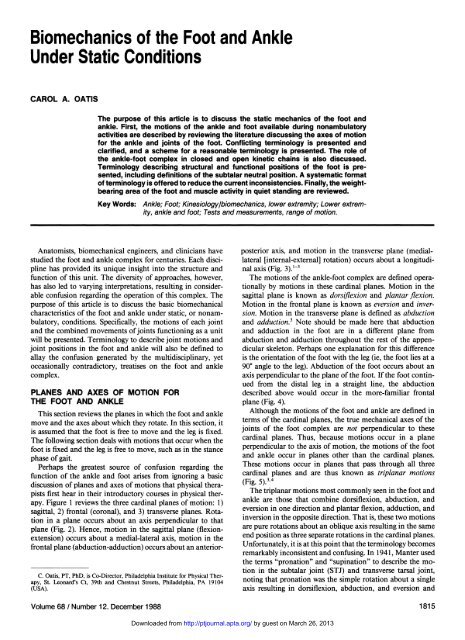Biomechanics of the Foot and Ankle Under Static ... - Physical Therapy
Biomechanics of the Foot and Ankle Under Static ... - Physical Therapy
Biomechanics of the Foot and Ankle Under Static ... - Physical Therapy
Create successful ePaper yourself
Turn your PDF publications into a flip-book with our unique Google optimized e-Paper software.
<strong>Biomechanics</strong> <strong>of</strong> <strong>the</strong> <strong>Foot</strong> <strong>and</strong> <strong>Ankle</strong><br />
<strong>Under</strong> <strong>Static</strong> Conditions<br />
CAROL A. OATIS<br />
The purpose <strong>of</strong> this article is to discuss <strong>the</strong> static mechanics <strong>of</strong> <strong>the</strong> foot <strong>and</strong><br />
ankle. First, <strong>the</strong> motions <strong>of</strong> <strong>the</strong> ankle <strong>and</strong> foot available during nonambulatory<br />
activities are described by reviewing <strong>the</strong> literature discussing <strong>the</strong> axes <strong>of</strong> motion<br />
for <strong>the</strong> ankle <strong>and</strong> joints <strong>of</strong> <strong>the</strong> foot. Conflicting terminology is presented <strong>and</strong><br />
clarified, <strong>and</strong> a scheme for a reasonable terminology is presented. The role <strong>of</strong><br />
<strong>the</strong> ankle-foot complex in closed <strong>and</strong> open kinetic chains is also discussed.<br />
Terminology describing structural <strong>and</strong> functional positions <strong>of</strong> <strong>the</strong> foot is presented,<br />
including definitions <strong>of</strong> <strong>the</strong> subtalar neutral position. A systematic format<br />
<strong>of</strong> terminology is <strong>of</strong>fered to reduce <strong>the</strong> current inconsistencies. Finally, <strong>the</strong> weightbearing<br />
area <strong>of</strong> <strong>the</strong> foot <strong>and</strong> muscle activity in quiet st<strong>and</strong>ing are reviewed.<br />
Key Words: <strong>Ankle</strong>; <strong>Foot</strong>; Kinesiology/biomechanics, lower extremity; Lower extremity,<br />
ankle <strong>and</strong> foot; Tests <strong>and</strong> measurements, range <strong>of</strong> motion.<br />
Anatomists, biomechanical engineers, <strong>and</strong> clinicians have<br />
studied <strong>the</strong> foot <strong>and</strong> ankle complex for centuries. Each discipline<br />
has provided its unique insight into <strong>the</strong> structure <strong>and</strong><br />
function <strong>of</strong> this unit. The diversity <strong>of</strong> approaches, however,<br />
has also led to varying interpretations, resulting in considerable<br />
confusion regarding <strong>the</strong> operation <strong>of</strong> this complex. The<br />
purpose <strong>of</strong> this article is to discuss <strong>the</strong> basic biomechanical<br />
characteristics <strong>of</strong> <strong>the</strong> foot <strong>and</strong> ankle under static, or nonambulatory,<br />
conditions. Specifically, <strong>the</strong> motions <strong>of</strong> each joint<br />
<strong>and</strong> <strong>the</strong> combined movements <strong>of</strong> joints functioning as a unit<br />
will be presented. Terminology to describe joint motions <strong>and</strong><br />
joint positions in <strong>the</strong> foot <strong>and</strong> ankle will also be defined to<br />
allay <strong>the</strong> confusion generated by <strong>the</strong> multidisciplinary, yet<br />
occasionally contradictory, treatises on <strong>the</strong> foot <strong>and</strong> ankle<br />
complex.<br />
PLANES AND AXES OF MOTION FOR<br />
THE FOOT AND ANKLE<br />
This section reviews <strong>the</strong> planes in which <strong>the</strong> foot <strong>and</strong> ankle<br />
move <strong>and</strong> <strong>the</strong> axes about which <strong>the</strong>y rotate. In this section, it<br />
is assumed that <strong>the</strong> foot is free to move <strong>and</strong> <strong>the</strong> leg is fixed.<br />
The following section deals with motions that occur when <strong>the</strong><br />
foot is fixed <strong>and</strong> <strong>the</strong> leg is free to move, such as in <strong>the</strong> stance<br />
phase <strong>of</strong> gait.<br />
Perhaps <strong>the</strong> greatest source <strong>of</strong> confusion regarding <strong>the</strong><br />
function <strong>of</strong> <strong>the</strong> ankle <strong>and</strong> foot arises from ignoring a basic<br />
discussion <strong>of</strong> planes <strong>and</strong> axes <strong>of</strong> motions that physical <strong>the</strong>rapists<br />
first hear in <strong>the</strong>ir introductory courses in physical <strong>the</strong>rapy.<br />
Figure 1 reviews <strong>the</strong> three cardinal planes <strong>of</strong> motion: 1)<br />
sagittal, 2) frontal (coronal), <strong>and</strong> 3) transverse planes. Rotation<br />
in a plane occurs about an axis perpendicular to that<br />
plane (Fig. 2). Hence, motion in <strong>the</strong> sagittal plane (flexionextension)<br />
occurs about a medial-lateral axis, motion in <strong>the</strong><br />
frontal plane (abduction-adduction) occurs about an anterior-<br />
C. Oatis, PT, PhD, is Co-Director, Philadelphia Institute for <strong>Physical</strong> <strong>Therapy</strong>,<br />
St. Leonard's Ct, 39th <strong>and</strong> Chestnut Streets, Philadelphia, PA 19104<br />
(USA).<br />
posterior axis, <strong>and</strong> motion in <strong>the</strong> transverse plane (mediallateral<br />
[internal-external] rotation) occurs about a longitudinal<br />
axis (Fig. 3). 1-3<br />
The motions <strong>of</strong> <strong>the</strong> ankle-foot complex are defined operationally<br />
by motions in <strong>the</strong>se cardinal planes. Motion in <strong>the</strong><br />
sagittal plane is known as dorsiflexion <strong>and</strong> plantar flexion.<br />
Motion in <strong>the</strong> frontal plane is known as eversion <strong>and</strong> inversion.<br />
Motion in <strong>the</strong> transverse plane is defined as abduction<br />
<strong>and</strong> adduction. 3 Note should be made here that abduction<br />
<strong>and</strong> adduction in <strong>the</strong> foot are in a different plane from<br />
abduction <strong>and</strong> adduction throughout <strong>the</strong> rest <strong>of</strong> <strong>the</strong> appendicular<br />
skeleton. Perhaps one explanation for this difference<br />
is <strong>the</strong> orientation <strong>of</strong> <strong>the</strong> foot with <strong>the</strong> leg (ie, <strong>the</strong> foot lies at a<br />
90° angle to <strong>the</strong> leg). Abduction <strong>of</strong> <strong>the</strong> foot occurs about an<br />
axis perpendicular to <strong>the</strong> plane <strong>of</strong> <strong>the</strong> foot. If <strong>the</strong> foot continued<br />
from <strong>the</strong> distal leg in a straight line, <strong>the</strong> abduction<br />
described above would occur in <strong>the</strong> more-familiar frontal<br />
plane (Fig. 4).<br />
Although <strong>the</strong> motions <strong>of</strong> <strong>the</strong> foot <strong>and</strong> ankle are defined in<br />
terms <strong>of</strong> <strong>the</strong> cardinal planes, <strong>the</strong> true mechanical axes <strong>of</strong> <strong>the</strong><br />
joints <strong>of</strong> <strong>the</strong> foot complex are not perpendicular to <strong>the</strong>se<br />
cardinal planes. Thus, because motions occur in a plane<br />
perpendicular to <strong>the</strong> axis <strong>of</strong> motion, <strong>the</strong> motions <strong>of</strong> <strong>the</strong> foot<br />
<strong>and</strong> ankle occur in planes o<strong>the</strong>r than <strong>the</strong> cardinal planes.<br />
These motions occur in planes that pass through all three<br />
cardinal planes <strong>and</strong> are thus known as triplanar motions<br />
(Fig. 5). 3,4<br />
The triplanar motions most commonly seen in <strong>the</strong> foot <strong>and</strong><br />
ankle are those that combine dorsiflexion, abduction, <strong>and</strong><br />
eversion in one direction <strong>and</strong> plantar flexion, adduction, <strong>and</strong><br />
inversion in <strong>the</strong> opposite direction. That is, <strong>the</strong>se two motions<br />
are pure rotations about an oblique axis resulting in <strong>the</strong> same<br />
end position as three separate rotations in <strong>the</strong> cardinal planes.<br />
Unfortunately, it is at this point that <strong>the</strong> terminology becomes<br />
remarkably inconsistent <strong>and</strong> confusing. In 1941, Manter used<br />
<strong>the</strong> terms "pronation" <strong>and</strong> "supination" to describe <strong>the</strong> motion<br />
in <strong>the</strong> subtalar joint (STJ) <strong>and</strong> transverse tarsal joint,<br />
noting that pronation was <strong>the</strong> simple rotation about a single<br />
axis resulting in dorsiflexion, abduction, <strong>and</strong> eversion <strong>and</strong><br />
Volume 68 / Number 12. December 1988 1815<br />
Downloaded from<br />
http://ptjournal.apta.org/ by guest on March 26, 2013
















